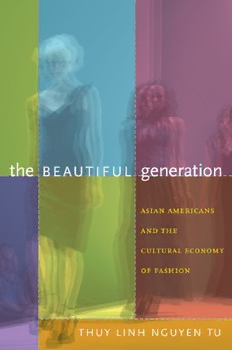
The Beautiful Generation: Asian Americans and the Cultural Economy of Fashion PDF
Preview The Beautiful Generation: Asian Americans and the Cultural Economy of Fashion
(cid:85)(cid:73)(cid:70)(cid:1)(cid:35)(cid:38)(cid:34)(cid:54)(cid:53)(cid:42)(cid:39)(cid:54)(cid:45)(cid:1)(cid:72)(cid:70)(cid:79)(cid:70)(cid:83)(cid:66)(cid:85)(cid:74)(cid:80)(cid:79) (cid:85)(cid:73)(cid:70)(cid:1)(cid:35)(cid:38)(cid:34)(cid:54)(cid:53)(cid:42)(cid:39)(cid:54)(cid:45)(cid:1)(cid:72)(cid:70)(cid:79)(cid:70)(cid:83)(cid:66)(cid:85)(cid:74)(cid:80)(cid:79) (cid:62)(cid:80)(cid:70)(cid:62)(cid:75)(cid:1)(cid:62)(cid:74)(cid:66)(cid:79)(cid:70)(cid:64)(cid:62)(cid:75)(cid:80)(cid:1) (cid:66)(cid:79)(cid:69)(cid:1)(cid:85)(cid:73)(cid:70)(cid:1)(cid:1) (cid:64)(cid:82)(cid:73)(cid:81)(cid:82)(cid:79)(cid:62)(cid:73)(cid:1)(cid:66)(cid:64)(cid:76)(cid:75)(cid:76)(cid:74)(cid:86)(cid:1) (cid:80)(cid:71)(cid:1)(cid:67)(cid:62)(cid:80)(cid:69)(cid:70)(cid:76)(cid:75) (cid:53)(cid:73)(cid:86)(cid:90)(cid:1)(cid:45)(cid:74)(cid:79)(cid:73)(cid:1)(cid:47)(cid:72)(cid:86)(cid:90)(cid:70)(cid:79)(cid:1)(cid:53)(cid:86) (cid:65)(cid:82)(cid:72)(cid:66)(cid:1)(cid:82)(cid:75)(cid:70)(cid:83)(cid:66)(cid:79)(cid:80)(cid:70)(cid:81)(cid:86)(cid:1)(cid:77)(cid:79)(cid:66)(cid:80)(cid:80)(cid:1) (cid:1) (cid:65)(cid:82)(cid:79)(cid:69)(cid:62)(cid:74)(cid:1)(cid:62)(cid:75)(cid:65)(cid:1)(cid:73)(cid:76)(cid:75)(cid:65)(cid:76)(cid:75)(cid:1) (cid:19)(cid:17)(cid:18)(cid:18) ∫ 2011 Duke University Press All rights reserved Printed in the United States of America on acid-free paper $ Designed by Heather Hensley Typeset in Scala by Keystone Typesetting, Inc. Library of Congress Cataloging-in-Publication Data appear on the last printed page of this book. To my mother CONTENTS acknowledgments ix introduction Fashion, Free Trade, and the ‘‘Rise of the Asian Designer’’ 1 Part I 1. Crossing the Assembly Line: Skills, Knowledge, and the Borders of Fashion 31 2. All in the Family? Kin, Gifts, and the Networks of Fashion 63 Part II 3. The Cultural Economy of Asian Chic 99 4. ‘‘Material Mao’’: Fashioning Histories Out of Icons 133 5. Asia on My Mind: Transnational Intimacies and Cultural Genealogies 169 epilogue 203 notes 209 bibliography 239 index 253 ACKNOWLEDGMENTS This book would not have been possible without the time, energy, and imagination of many friends, colleagues, and kind strangers. It is a pleasure to be able to acknowledge them here. I want to begin by thanking all the designers who allowed me to talk with them, hang around their shops, and learn from them. Knowing what I now know about the demands of their work, I am even more amazed that they could find so much time for me. Without their generosity, I would not have this story to tell. The seeds of this book were planted many years ago, but they really grew in conversation with the wonderful colleagues, at di√er- ent institutions, who have read, heard, or talked about these ideas with me, including Christine Balance, Luz Calvo, Derek Chang, Beth Coleman, Iftikhar Dadi, Maria Fernandez, Wen Jin, James Kim, Nhi Lieu, Christina Moon, Viranjini Munsinghe, Mimi Ngu- yen and Minh-Ha Pham (and their spot-on blog, Threadbared), Je√rey Santa Anna, Barry Shank, Julie Sze, Elda Tsou, K. Scott Wong, Shelley Wong, and Judy Wu. Thanks to all their insights, this project became much more than I alone could have imagined. I am indebted in particular to the faculty of the Department of Social and Cultural Analysis at New York University. I joined the department just as I was completing this manuscript, and I can think of few places where I could have learned from more dy- namic scholars. Arlene Davila, Julie Elman, Jennifer Morgan, Crystal Parikh, Anne Rademacher, Sukhdev Sandhu, Nikhil Pal Singh, and Caitlin Zaloom all took time to read drafts, talk through ideas, or to sneak o√ for a drink. Thank you for the direction and
